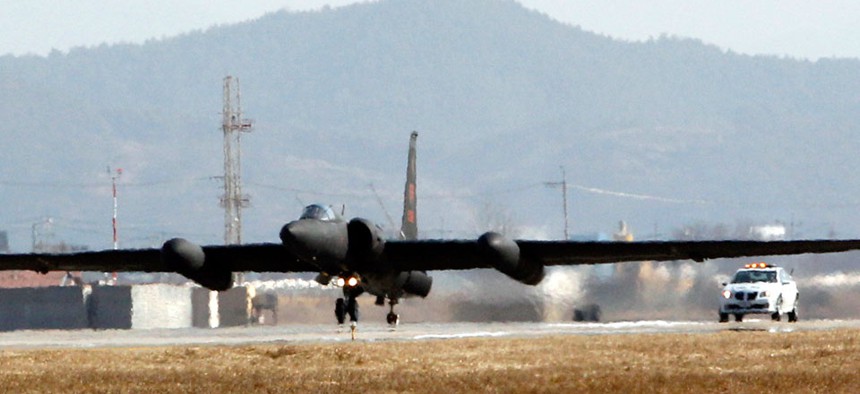The RFP for the U-2 Spy Plane Was Just Two Pages Long

A U.S. Air Force U-2 spy plane takes off from the U.S. airbase in Osan, south of Seoul, South Korea. Lee Jin-man/AP
The acquisition shows how government contracting has changed and stayed the same.
Federal Communications Commission CIO David Bray dropped an interesting piece of government contracting arcana last week during a panel discussion on the past and future role of government chief information officers.
The conversation had turned to the acquisition process and how its complexities can sometimes prevent agencies from buying the best technology or prolong the process until that technology is sorely out of date. Bray noted that the request for proposals for the U-2 spy plane -- the one that secretly flew over the Soviet Union gathering intelligence at high altitudes for half a decade during the early Cold War -- was only two pages long.
That’s quite a contrast to modern RFPs, which can run dozens or hundreds of pages for comparatively simple technology.
Unfortunately the full U-2 RFP isn’t easily available online. There are several reference notes, though, attesting to its two-page length. Just as interesting, though, for anyone who’s worked under the contemporary Federal Acquisition Regulation, is this description of the U-2 contracting process compiled by Central Intelligence Agency historians Gregory Pedlow and Donald Welzenbach in 1998.
The story begins with a little preferential treatment:
“The Wright Air Development Command decided not to seek proposals from major airframe manufacturers on the grounds that a smaller company would give the new project a higher priority and produce a better aircraft more quickly.”
The government picked three small firms to develop full proposals. The plot thickened, though, when “word of the competition for a new reconnaissance airplane…reached another manufacturer, the Lockheed Aircraft Corporation, which submitted an unsolicited design.” With its greater pool of resources, Lockheed was quickly able to best the competition.
There’s another piece of the story, however, that will be all too familiar to contemporary government technologists. Designers were eager that production of the spy plane proceed as fast as possible so the technology wouldn’t become outdated.
Outdated technology in the contemporary civilian government might mean an agency running an old version of Windows. In the military context of 1954, it meant Soviet weapons’ ability to shoot down U.S. aircraft might outpace U.S. aircrafts’ ability to fly above them.
Here’s the key paragraph:
“[Lockheed Executive John] Carter [who’d recently retired from the Air Force] noted that the proposed aircraft would have to reach altitudes of between 65,000 and 70,000 feet and correctly forecast, ‘If extreme altitude performance can be realized in a practical aircraft at speeds in the vicinity of Mach 08, it should be capable of avoiding virtually all Russian defenses until about 1960.’ Carter added, ‘To achieve these characteristics in an aircraft which will have a reasonably useful operational life during the period before 1960 will, of course, require very strenuous efforts and extraordinary procedures, as well as nonstandard design philosophy.’ Some of the ‘nonstandard’ design characteristics suggested by Carter were the elimination of landing gear, the disregard of military specifications, and the use of very low load factors. Carter’s memorandum closed with a warning that time was of the essence: ‘In order that this special aircraft can have a reasonably long and useful life, it is obvious that its development must be greatly accelerated beyond that considered normal.’”
Carter’s warning proved prescient, of course, as it was in 1960 -- and at the height of the Kennedy-Nixon electoral battle -- when pilot Francis Gary Powers was successfully shot down by Soviet missiles and the U-2 program was first exposed to the American public.
This post has been updated to correctly describe the Soviet method for shooting down the U-2.



